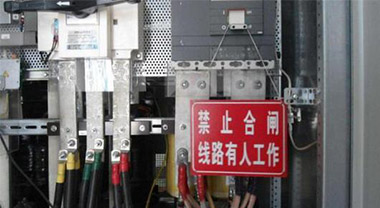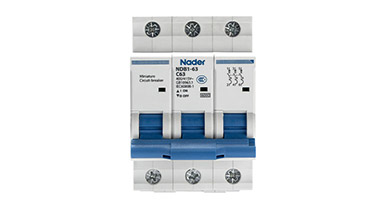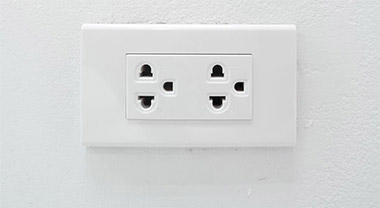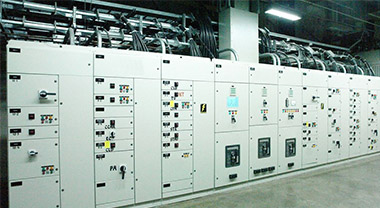The difference between circuit breaker 1p and 2p
For miniature circuit breakers, 1P+N, 1P, 2P are generally used as on-off control of single-phase electrical appliances, but the effects are different.
1P-single pole circuit breaker, with thermal and magnetic trip function, only control live wire (phase wire), modulus 18mm; 1P+N-single pole +N circuit breaker, control live wire and neutral wire at the same time, but only live wire has thermal magnetic Tripping function; the modulus is also 18mm; 2P-single-phase 2-pole circuit breaker, which controls the live and neutral wires at the same time, and both have the thermal and magnetic tripping function, the modulus is 2*18mm=36mm.
Therefore, the following conclusions can be drawn:
1. In order to reduce the cost, 1P can be used, but the upper-level circuit breaker must have a leakage trip function. In order to prevent accidents caused by fire and zero disorder during maintenance, the upper-level power supply must be cut off;
2, in order to avoid the problem of 1 item during maintenance, 1P+N (ie DPN) can be used;
3. Reasons for using 2P: For the circuit breaker housing with the same 18mm modulus, there is a difference between installing 1P and 1P+N inside. The former has a higher "limit breaking capacity" in a short-circuit accident state. After all, space is an important factor affecting the breaking capacity. Therefore, it is better to use 2P (higher cost) for more important power circuits, frequent maintenance and operation, and prone to failure.
4. The premise of using 1P is that the lighting distribution box must have a leakage trip function, and at least the incoming line (or the upper level of the outgoing line) must use a leakage circuit breaker.
1P+N is also DPN, which refers to a phase wire + a neutral wire. This phase wire pole has normal breaking capacity (that is to disconnect by hand) and protection and breaking functions such as overload and short circuit (that is, failure It will automatically disconnect afterwards), and this neutral pole (marked N on the circuit breaker) has only normal breaking capacity (disconnected by hand), and does not have the protective breaking function. It is one of the Schneider C65 series.
And 2P means that whether it is a phase wire + a neutral wire or two phase wires, both poles have normal breaking capacity (disconnect by hand) and protective breaking function (that is, failure Automatically disconnect afterwards). Schneider C32, C45, C65 all have this model. Relatively speaking, 1P+N is cheaper than 2P. In other words, the application of 2P is more extensive than that of 1P+N.
It is not like 1P+N as everyone said above, usually refers to leakage circuit breaker. Do you understand this time?
Ordinary socket circuit can use 1P+N, but if you want to add leakage, it will not work, because DPN (1P+N) circuit breakers cannot be assembled with leakage protection accessories and other electrical accessories. Its other parameters are: the tripping curve is type C (dedicated to power distribution protection); the width of the circuit breaker is 18mm; the rated current is 3A, 6A, 10A, 16A, 20A. If you want to carry leakage current, you can choose to use DPNK type, DPN N type, DPNvigi and DPNvigi G, DPN N vigi type, etc. You can also use C65N-C 20A/2P+VE type circuit breaker. The difference between 1p+n and 2p 1P+ N is a 1p circuit breaker with double breakpoints, which is protected on the live line, and the N line contact moves together with the live line contact. What is the difference between 1P+N and 2P?
1P+N is more economical. 2p is seldom used. When there is no 1P+N, the 2P switch is used to disconnect the neutral line at the same time. The common point is that the phase line and the neutral line can be disconnected at the same time. The difference is 1P+N. The live wire is protected, the neutral wire is not protected, and the 2P live wire neutral wire is protected.
1: The difference between 1P+N and 2P micro disconnection: The N line of 1P+N circuit breaker has no overload and short circuit protection functions; the advantage is that the circuit breaker is small in size and cheap.
2: Choose 1P+N or 2P circuit breakers for residential socket circuits: For single-phase circuits, the currents of the N line and the phase line are similar, so there is no need for separate protection for the N line, and 1P+N micro-break can be used, but Pay attention to its breaking capacity parameters when selecting.
3: Article 6.5.1.5 of "Code for Residential Design" GB50096-1999 stipulates: "Each house should be equipped with a mains circuit breaker, and switch appliances that can disconnect the phase and neutral lines at the same time should be used."
Article 6.5.1.7 stipulates: "The main power incoming circuit breaker of each house shall have leakage protection function."
4: Article 8.5.4 of "Code for Residential Buildings" GB50368-2005 stipulates: "Each house should be equipped with a main power circuit breaker, and the main circuit breaker should be a switching device that can simultaneously disconnect the phase and neutral wires."




